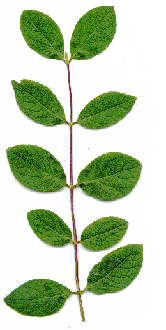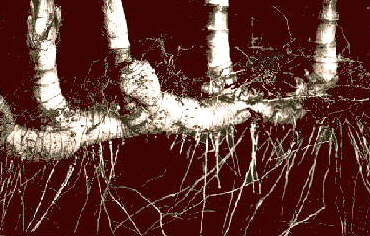Typically, flowering plants are organized into an underground root and a shoot above ground that itself consists of a stem and leaves. The stem is the main supporting axis of a flowering plant. It is made up of nodes, the part where one or more leaves are borne and of the usually longer, in-between lying internodes. Stems are characterized by their type of branching, by their surface and their symmetry. Special cases of stems are those of climbing plants, succulence, runners and rhizomes.
 Shoot
and root can be clearly distinguished within a seed. After
germination, they do develop into the shoot that grows towards the
sun and into the root which grows towards the earth's score. The
shoot that develops during the first stage of development is called
the main- or the primary shoot and depending on the plant, it does
bear one, two, or more cotyledons. Growing and sprouted shoots are
organized into nodes and the
in-between lying internodes. The
nodes are the parts where the leaves are inserted. At the tip of a
growing shoot sits the terminal bud of the shoot apex that is
surrounded by the leaf (or flower) primordias. In the area of the
nodes are axillary buds where the axillary shoots insert.
Shoot
and root can be clearly distinguished within a seed. After
germination, they do develop into the shoot that grows towards the
sun and into the root which grows towards the earth's score. The
shoot that develops during the first stage of development is called
the main- or the primary shoot and depending on the plant, it does
bear one, two, or more cotyledons. Growing and sprouted shoots are
organized into nodes and the
in-between lying internodes. The
nodes are the parts where the leaves are inserted. At the tip of a
growing shoot sits the terminal bud of the shoot apex that is
surrounded by the leaf (or flower) primordias. In the area of the
nodes are axillary buds where the axillary shoots insert.
Vegetable shoots are either annual or perennial. The realised alternative depends usually on the species and in some species on the quality of the environment.
The shoot of annual species is mostly fleshy and is usually called a stalk while perennial plants lignify and thus form trunks and branches. Some species, like Graminaceae or Poaceae have a hollow stalk that is called a blade of grass.
To characterize a shoot, its type of branching and its surface (smooth, hairy, with or without grooves, round or squared) is used, as well as the ratio of heights to diameter.
It can generally be distinguished between monopodial and sympodial branching. Monopodial branching exists, if a continuous main shoot has feeble apical shoots. Sympodial branching is given, if apical shoots of different generations exist at the same time since the apical meristem of each sympodial branch has either died or is differentiated into a flower, a thorn or a tendril and has thus lost its ability to grow. The respective shoot tip is nearer to the ground than that of the next apical shoot. If only one of the apical shoots has the same direction as the main shoot would have had, then a monochasium results which may sometimes be difficult to distinguish from monopodial branching. But if two buds of a sympodial branch sprout at the same time, a more or less fork-shaped pattern, a dichasium, is formed. Hardly ever do several buds put forth at the same time (pleiochasium).
An extreme ratio of heights to diameter is found in climbing plants where the diameter (and the stability) is very small compared to the length so that upright growing is only possible with the support of other plants or growing aids. Succulence is another extreme, that is typical for plants living in arid or saline habitats.
Most shoots are of a radial symmetry but with a few species, the apical shoots may be changed into flat, leaf-like phylloclades. Often, especially with wooden plants, the axes are differentiated into long and short shoots. The internodes of the long shoots that cause elongation with trees and shrubs are longer than the short shoots. These again are often specialized apical shoots with shortened internodes. The thorns of white-horn (Crataegus), for example, or those of sloe (Prunus spinosa) correspond to such short shoots.

Apical shoots may, too, be changed into runners or rhizomes.
Runners are horizontally growing shoots
with greatly prolonged internodes that are either underground or
above ground and are sometimes bearing leaves. The internodes produce
sometimes roots at the part that is nearest to the main shoot
(shoot-borne roots). Some parts of these runners can switch to an
upright growth and thus behave like a normal shoot. They serve to
propagate vegetatively (strawberries are a typical example).
Rhizomes are mostly underground
and grow in a horizontal (plagiotrop) manner. They are rather
enduring shoots whose internodes usually stay short. They serve as
survival organs and are often at the same time used for storage;
sometimes, they end in specially developed storage tubers like in
potatoes. Except for small, scale-like leaves, rhizomes do usually
have no leaves. Shoots which happen to come into touch with a moist
soil surface may start to develop leaves and flowers (Iris,
Arundo, see picture to the left).
|
|